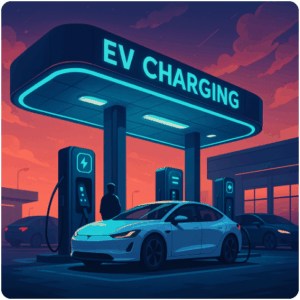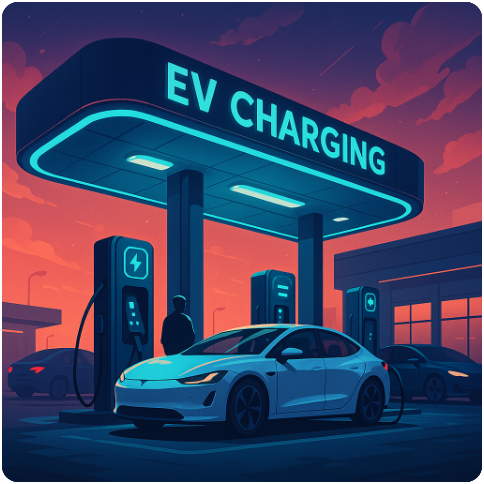Tag: Electric Vehicles
EV Charging May Be Coming to a Gas Station Near You
 Of the many concerns that keep car buyers from taking the plunge into EV ownership, access to fast, on-the-road charging remains at the top of the list. While Tesla has largely solved this problem through its fast charger network, the other 50 percent of EV owners in the U.S. must resort to a hodgepodge of charging pumps, many of which are unreliable, inconveniently located, and take too long to charge.
Of the many concerns that keep car buyers from taking the plunge into EV ownership, access to fast, on-the-road charging remains at the top of the list. While Tesla has largely solved this problem through its fast charger network, the other 50 percent of EV owners in the U.S. must resort to a hodgepodge of charging pumps, many of which are unreliable, inconveniently located, and take too long to charge.
To be sure, the problem is at least partially solved for some EV owners, who can charge their car overnight in their own garage. Yet the problem remains for EV owners that live in townhomes, condominiums, and apartments, without a dedicated garage.
Nouria, a chain of combination gas stations and convenience stores, which operates in more than 180 locations throughout the Northeast, has taken steps to solve the problem. In addition to the typical array of beef jerky sticks available at most gas stations, Nouria goes several steps further, providing an eclectic mix of merchandise, including stuffed animals, Ashton Churchill cigars, healthy snacks, and of course, potato chips and candy bars. As an added convenience, a Dunkin’ Donuts concession provides chocolate glazed, jelly, and butternut donuts, along with blueberry munchkins.
Its filling station in Framingham Massachusetts, located twenty miles from Boston as the crow flies, provides five stalls with two pumps on each side, where up to ten drivers can fill their gas tanks at once. In an accessible area adjacent to the filling pumps reside two ChargePoint Level 3 EV chargers, ready to provide a relatively quick electron boost. Over time, as I’ve routinely stopped for a Dunkin’ butternut donut, I’ve seen Rivian R1Ts, Volkswagen ID.4s, a few Hyundai Ioniq 5s, a couple of Honda Prologues, and several Ford Mustang Mach-Es take their turns in the charging bays.
Recently, I chatted with a couple who were on their way back to their home in Western Massachusetts. They were happy to have found the Nouria station on their Rivian app, which enabled them to charge their R1T pickup truck in something like 20 minutes, though I don’t recall how much range they had left on their battery before stopping at the station. And they didn’t have to drive far out of their way to find it, as the Framingham location is close to the Massachusetts Turnpike entrance. For what it’s worth, they were so enthusiastic about their Rivian that they volunteered to show me the ample trunk space under the front hood, where the engine normally sits in a gas powered pickup truck.
Gas nozzles outweigh EV chargers by a ratio of 5:1 at this particular filling station, yet while on a recent stop, I saw just two cars filling up for gas, while both chargers were occupied. As I washed down my Dunkin munchkin with a swig of coffee, I thought: could this be a glimpse into the future?
Less than two percent of all cars in Massachusetts are EVs, but EVs now account for 12 percent of all new cars purchased in the state, according to the Alliance for Automotive Information. Nouria has placed a bet that the numbers will rise, and perhaps over time more EV chargers will be added to more of its locations. In the meantime it will be interesting to see if others in the convenience store and gas station business begin to add EV chargers. The pace of EV adoption and demand for charging services will no doubt dictate the decision.
The Cure for EV Range Anxiety Is Coming

By Ben Z. Rose
Dec 27, 2023, 2:00 am EST
 Of all the obstacles to broader adoption of electric vehicles, the lack of publicly available car chargers is the one cited most frequently. If we are to believe industry pundits, traditional car drivers are scared to death of buying an EV for fear of draining the battery and getting stuck on the side of the road of some backwoods hamlet, or worse, getting ensnared in city traffic. The fear of an empty battery has led to a condition commonly referred to as range anxiety. And it persists, despite the industry’s best efforts to treat it.
Of all the obstacles to broader adoption of electric vehicles, the lack of publicly available car chargers is the one cited most frequently. If we are to believe industry pundits, traditional car drivers are scared to death of buying an EV for fear of draining the battery and getting stuck on the side of the road of some backwoods hamlet, or worse, getting ensnared in city traffic. The fear of an empty battery has led to a condition commonly referred to as range anxiety. And it persists, despite the industry’s best efforts to treat it.
Great strides have been made to extend EV battery life in the last few years. It’s unusual today for an EV to have a charging range of less than 250 miles, with 300 miles or more increasingly common. This is farther than many cars and pickup trucks can drive on a single tank of gas. Moreover, the number of publicly available charging stations is rising, with the ratio of EVs to charging ports falling rapidly. Even fast chargers are now rising as a portion of charger infrastructure. Fast chargers are like highway gas stations for EVs—they let drivers pull in and quickly refill most of their charge.
In Massachusetts, for example, EVs make up about 1% of all registered light vehicles. The state has one fast charger for every 75 EVs, while the ratio of registered light vehicles to gasoline pumps is one to 196 (assuming 10 pumps per gas station). And more innovations are in the works: Members of AAA can now obtain roadside EV charging services in 15 cities around the U.S., including West Springfield, Mass.
Yet there remain real reasons to worry about taking an EV out on a road trip. First of all, the number of fast chargers is greatly skewed in favor of urban, versus rural areas. Most charging stations have only one or two charging ports, and since even fast charging can take 15-45 minutes depending on the battery, lines can form quickly. That can get stressful when many charging facilities are unmanned and fully self-service. By contrast, there is hardly ever a line at the local gas station, or at a Cumberland Farms, which may have as many as 16 pumps working at once. It’s also nice to know that if you have a problem with your credit card, there’s a person on premise in the form of a cashier or attendant that can resolve it. Being able to buy a bag of peanuts, a cup of coffee, or use the restroom, is of course a bonus.
This stands in contrast to many EV chargers, which have difficulty reading a credit card. This assumes that the charger is in working order when you reach it. Far too many are not. And getting to one is not an easy feat either, especially when it’s located away from a main highway, tucked away in the back of a motel, school, or even a shopping center. Tesla drivers have it easier, with access to a more-reliable, national network. But drivers of EVs from one of the automakers also need to worry whether their EV will work with the available charger’s plug. No one ever needs to worry about whether a gasoline pump will fit into their tank.
Fortunately, help is on the way. Tesla’s clever decision to open a portion of its fast charger network (and thus defray the costs of operating it) to other manufacturers, including GM, Ford, Volvo, Mercedes-Benz, Nissan, Honda Motor, BMW, Toyota, Rivian Automotive, and several others, will help to alleviate the problem. Tesla has also made its charging standard available to charger manufacturers. This could both increase the availability and reliability of chargers, in much the same way that Microsoft’s decision to open up its Windows user interface to other software makers made it easier to write software for a larger audience.
Indeed, the time will come—perhaps only in a few years—when EV Range Anxiety can not only be treated, but cured. Until that day arrives, those still on the fence about buying an EV can focus on other pet peeves, such as the still-high unsubsidized price of most EVs, the poor performance of in-car electronics, fear of losing battery life in cold weather, and, for some models, the high cost of repairs.
Guest commentaries like this one are written by authors outside the Barron’s and MarketWatch newsroom. They reflect the perspective and opinions of the authors. Submit commentary proposals and other feedback to ideas@barrons.com.


